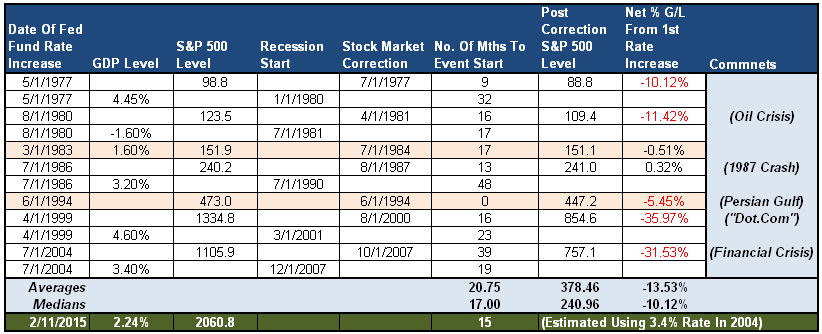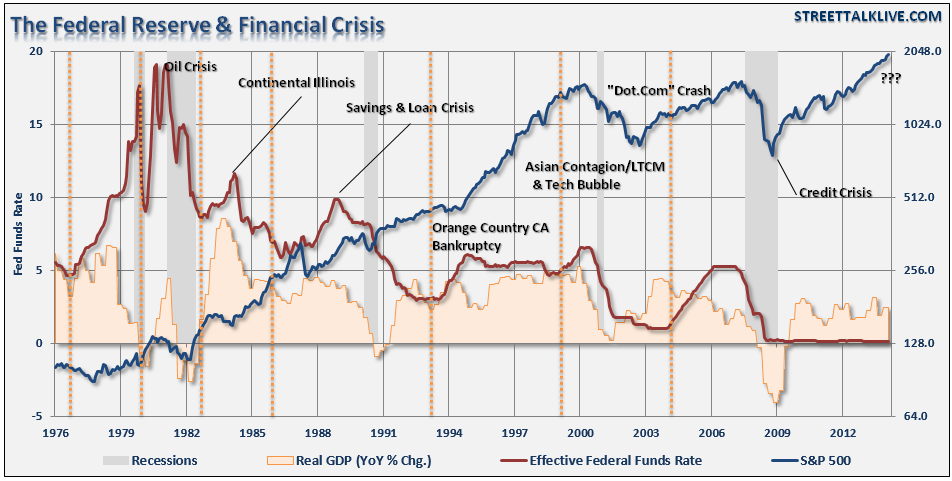With the Federal Reserve now indicating that they are "really serious" about raising interest rates, there have come numerous articles and analysis discussing the impact on asset prices. To wit:
"'Stocks typically sell-off on the first of a series of rate hikes, but the magnitude and duration of the sell-off depend on conditions,' Bianco writes. 'During early cycle hikes the initial sell-off was generally small, quickly recovered and further S&P [500] gains came in next three months and longer (like 2004, 1983, 1972). But many sell-offs on late cycle hikes became corrections or even bear markets.'
Unfortunately, it's only in hindsight do we know where we are in the cycle.
While David is correct in his analysis, in my view, it is too short of a window for investors. While the markets, due to momentum, may ignore the effect of "monetary tightening" in the short-term, what about longer-term?
That is the question I want to examine today. As shown in the table below, the bulk of losses in markets are tied to economic recessions. However, there are also other events such as the Crash of 1987, the Asian Contagion, Long-Term Capital Management and others that led to sharp corrections in the market as well.
The next table shows the date of the first Fed rate hike, the corresponding level of GDP at the time of the first rate hike and the financial markets. It also counts the number of months until the next event, which was either a recession, a market correction or both.
The point is that in the short-term the economy and the markets (due to the current momentum) can SEEM TO DEFY the laws of gravity as interest rates begin to rise. However, as rates continue to rise they ultimately acts as a "brake" on economic activity. Think about the all of the areas that are NEGATIVELY impacted by rising interest rates:
1) Rising interest rates raise the debt servicing requirements which reduces future productive investment.
2) Rising interest rates will immediately slow the housing market taking that small contribution to the economy away. People buy payments, not houses, and rising rates mean higher payments.
3) An increase in interest rates means higher borrowing costs which leads to lower profit margins for corporations. This will negatively impact corporate earnings and the financial markets.
4) One of the main arguments of stock bulls over the last 5-years has been the stocks are cheap based on low interest rates. When rates rise the market becomes overvalued very quickly.
5) The massive derivatives and credit markets will be negatively impacted. Much of the recovery to date has been based on suppressing interest rates to spur growth.
6) As rates increase so does the variable rate interest payments on credit cards. With the consumer being impacted by stagnant wages and increased taxes, higher credit payments will lead to a rapid contraction in income and rising defaults.
7) Rising defaults on debt service will negatively impact banks which are still not adequately capitalized and still burdened by large levels of bad debts.
8) Many corporate share buyback plans and dividend issuances have been done through the use of cheap debt, which has led to increases corporate balance sheet leverage. This will end.
9) Corporate capital expenditures are dependent on borrowing costs. Higher borrowing costs leads to lower capex.
10) The deficit/GDP ratio will begin to soar as borrowing costs rise sharply. The many forecasts for lower future deficits will crumble as new forecasts begin to propel higher.
I could go on, but you get the idea.
However, the mainstream media continues to run with the idea that you shouldn't fear the Fed beginning to increase interest rates. This is something that I addressed more deeply in "Don't Fear Rising Interest Rates? Really?"
"Do Rising Interest Rates Lead To Higher Stock Prices? This claim falls into the category of 'timing is everything.' The chart below has been circulated quite a bit to support the "don't fear rising interest rates" meme. I have annotated the chart to point out the missing pieces.
As I stated above, timing is everything. While rising interest rates may not "initially" drag on asset prices, it is a far different story to suggest that they won't. In fact, there have been absolutely ZERO times in history that the Federal Reserve has begun an interest rate hiking campaign that has not eventually led to a negative outcome.
What the majority of analysts fail to address is the "full-cycle" effect from rate hikes. While equities may initially provide a haven from rising interest rates during the first half of the rate cycle, they have been a destructive place to be during the last half.
While the mainstream analysis is not to fear rising interest rates in the short-run, as longer-term investors it is crucially important to the preservation of investment capital to understand the dynamics of increasing interest rates.
In summary, here are the things that you need to know:
1) There have been ZERO times that the Federal Reserve has entered into a rate hiking campaign that did not have a negative consequence.
2) The average period following an increase in the effective funds rate to either a stock market correction, economic recession or both has been 20.75 months. Therefore, if we assume an initial increase in the Fed funds rate in June of 2015, that would put the next negative event sometime in the first quarter of 2017.
3) However, the median number of months following the initial rate hike has been 17 months. This would advance the timeframe into mid-2016. Such a time frame would coincide with both the Decennial and Presidential cycles as discussed previously.
4) Importantly, there have been only two times in recent history that the Federal Reserve has increased interest rates from such a low level of annualized economic growth. The most relevant period was in 1983 when the economy was recovering from two adjacent recessions. Due to such weak economic growth, the impact of rising interest rates tripped up the stock market just 17 months later.
5) Lastly, it is crucially important to recognize that the ENTIRETY of the "bullish" analysis is based on a sustained 34-year period of falling interest rates, inflation and annualized rates of economic growth. With all of these variables near historic lows, we can only really guess at how asset prices, and economic growth, will fair going forward.
What is clear from the analysis is that bad things have tended to follow the Federal Reserve's first interest rate increase. While the markets, and economy, may seem to perform okay during the initial phase of the rate hiking campaign, the eventual negative impact will push most individuals to "panic sell" near the next lows. Emotional mistakes are 50% of the cause as to why investors consistently underperform the markets over a 20-year cycle.
For now the bullish trend is still in place and should be "consciously" honored. However, while it may seem that nothing can stop the markets current rise, it is crucial to remember that it is "only like this, until it is like that." For those "asleep at the wheel," there will be a heavy price to pay when the taillights turn red.




